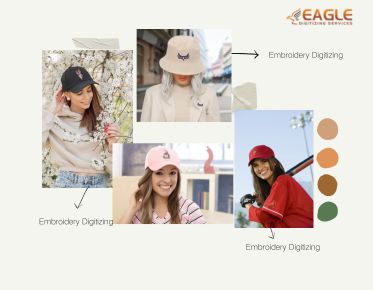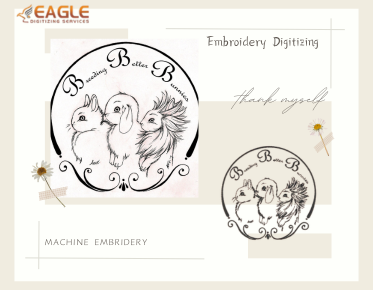The Battle of Styles: Digitized Embroidery Vs. Embossing
In the world of design, two techniques have emerged as standout contenders for adding texture and flair: digitized embroidery and embossing. While both methods bring unique depth to fabrics and surfaces, they cater to different tastes and creative visions. Embroidery, with its intricate threadwork, evokes a sense of tradition and craftsmanship, while embossing creates a sleek, raised effect that’s more contemporary and minimalistic. In this article, we’ll explore the differences between these two popular styles and help you decide which one best fits your next project.
Key Differences Between Digitized Embroidery and Embossing
Texture and Dimension: How They Differ
At first glance, digitized embroidery and embossing may appear similar, yet they offer distinct textures and dimensions. Digitized embroidery introduces a tactile quality through raised stitches, which can vary in density and style. In contrast, embossing relies on a flat surface that gains dimension through raised or indented designs. While embroidery invites a sense of softness and warmth, embossing presents a sleek, polished finish that speaks to modern elegance. Both techniques provide unique textural experiences, enriching the overall aesthetic of a project.
Visual Impact: Comparing Aesthetics in Both Techniques
The visual impact of digitized embroidery and embossing is undeniably captivating, yet they evoke different feelings. Digitized embroidery showcases intricate thread patterns and vibrant colors, drawing the eye to its textured surface. It tells a story through the interplay of thread and fabric. Conversely, embossing creates an understated elegance, where light and shadow play across the raised design, adding depth without overwhelming the viewer. Each technique has its aesthetic appeal, allowing creators to select the one that best aligns with their artistic vision.
Durability and Wear: Which Technique Lasts Longer?
When it comes to durability, both digitized embroidery and embossing have their merits, but their longevity can vary based on usage and care. Digitized embroidery is often highly durable, withstanding frequent washing and wear, making it an excellent choice for clothing and accessories. However, the longevity of the embroidery depends on the quality of threads and stabilization methods used. Embossing, while visually striking, may be more susceptible to wear and tear over time, particularly on flexible materials. Ultimately, the choice between the two techniques may hinge on the intended use of the final product.
Design Versatility: Embroidery vs. Embossing
Customization Options in Digitized Embroidery
One of the most appealing aspects of digitized embroidery is its remarkable customization potential. Designers can manipulate every aspect of their designs, from colors and sizes to stitch types and densities. This versatility allows for unique creations tailored to specific preferences and projects. Whether it’s adding a personal touch to a garment or creating custom logos for businesses, digitized embroidery caters to a wide array of design needs, making it a favorite among creatives.
Design Limitations in Embossing: What to Consider
While embossing offers stunning results, it does come with design limitations that require careful consideration. The intricacy of the design is often constrained by the material and embossing technique used. Highly detailed images may not translate well, as small elements can be lost in the process. Additionally, the choice of materials can affect the depth and clarity of the embossed design. Understanding these limitations is essential for achieving successful results, and ensuring that the final piece reflects the intended vision.
How Each Technique Handles Complex Designs
When it comes to handling complex designs, digitized embroidery tends to shine. Its ability to accommodate intricate details and a variety of colors makes it well-suited for elaborate creations. In contrast, embossing may struggle with overly complex designs, as the clarity and depth of the image can diminish. Designers should consider the nature of their projects when choosing between these two techniques, as the complexity of the design may dictate the most suitable approach.
Production Processes: Time and Costs
Time Investment: How Long Does Each Process Take?
The time investment for digitized embroidery and embossing can differ significantly. Creating a digitized embroidery design involves several stages, including design, digitization, and machine setup. While modern machines can stitch quickly, the overall process may take several hours, especially for intricate designs. On the other hand, embossing can be relatively quick, particularly for simpler designs. Once the setup is complete, the actual embossing process can be executed swiftly, allowing for rapid production. Understanding the time implications is essential for meeting deadlines and managing expectations.
Cost Analysis: Comparing the Financial Aspects
Cost is a crucial factor in choosing between digitized embroidery and embossing. Digitized embroidery often entails initial investments in equipment and software, which can add to the overall expense. However, once the setup is in place, the cost per unit decreases significantly, especially for larger production runs. Embossing, while typically less expensive to set up, may incur costs related to materials and the intricacies of the technique. A thorough cost analysis can guide decision-making, ensuring that the chosen method aligns with budget constraints.
Efficiency in Production: Which Technique Wins?
When evaluating efficiency, digitized embroidery often emerges as the champion for larger production runs. Once the initial setup is complete, machines can produce consistent, high-quality results with minimal intervention. In contrast, embossing may require more hands-on involvement, particularly for intricate designs that demand meticulous attention. However, for smaller projects or one-off designs, embossing can be incredibly efficient. The choice of technique ultimately depends on the scale of production and specific project requirements.
Choosing the Right Technique for Your Project
Factors to Consider When Selecting a Technique
Choosing between digitized embroidery and embossing requires careful consideration of several factors. Project scope, budget, and design complexity all play a significant role in decision-making. Additionally, the desired texture and visual impact will influence which technique is more suitable for the project. Assessing these elements thoughtfully will guide you toward the right choice, ensuring that the final product aligns with your vision and goals.
The Importance of End Use: What Are You Making?
The end use of the product is paramount when selecting a technique. Consider how the finished piece will be utilized—will it be worn, displayed, or used functionally? Digitized embroidery is often ideal for apparel and accessories, where durability and personalization are crucial. Conversely, embossing may be more suitable for decorative items or packaging, where texture and visual appeal take precedence. Understanding the purpose of the project will help clarify which technique is most appropriate.
Personal Style and Branding: How to Align Your Choice
Aligning your technique choice with personal style and branding is essential for achieving cohesive results. Consider how each method reflects your brand’s identity—digitized embroidery may convey a sense of warmth and craftsmanship, while embossing could express sophistication and modernity. By selecting the technique that resonates with your aesthetic and message, you’ll create a final product that is not only visually stunning but also true to your creative vision.
Applications in Fashion and Decor
Where Digitized Embroidery Shines: Fashion and Accessories
Digitized embroidery has carved a niche for itself in the fashion industry, adorning everything from casual wear to high-end couture. The versatility of embroidery allows designers to personalize garments, create eye-catching logos, and add unique embellishments to accessories. Whether it’s a stunning embroidered jacket or a chic embroidered handbag, this technique offers endless possibilities for creativity and expression in the realm of fashion.
Embossing in Home Decor: Texture and Style
In the world of home decor, embossing takes center stage as a technique that adds depth and character to various items. From embossed wallpaper and textiles to decorative elements on furniture, this method enhances the aesthetic appeal of spaces. By incorporating embossed designs, homeowners can achieve a sophisticated look that elevates their interior design, creating an inviting atmosphere rich in texture.
Real-World Examples: Successful Projects in Both Techniques
Numerous successful projects illustrate the beauty and versatility of both digitized embroidery and embossing. For instance, high-end fashion brands often use digitized embroidery to showcase intricate logos and designs on their apparel, establishing a unique identity. Meanwhile, boutique home decor brands frequently employ embossing to create exquisite products, such as leather journals or decorative cushions, that exude elegance. These examples highlight the transformative power of each technique across various industries.
Combining Techniques for Unique Designs
The Power of Hybrid Designs: Embroidery Meets Embossing
Combining digitized embroidery and embossing can lead to breathtaking hybrid designs that captivate the imagination. By merging the tactile qualities of embroidery with the sleek elegance of embossing, creators can craft pieces that stand out in a crowded marketplace. For example, an embroidered floral design can be enhanced with embossed accents, creating a multi-dimensional effect that draws the eye and invites touch. The synergy between these techniques opens up new avenues for creative exploration.
Tips for Seamlessly Integrating Embroidery and Embossing
To seamlessly integrate embroidery and embossing, careful planning is essential. Start by selecting complementary designs that enhance each other, ensuring that the elements work harmoniously. Experiment with placement and scaling to find the perfect balance between the two techniques. Additionally, consider the materials being used—choosing fabrics that support both techniques can result in stunning outcomes. With a thoughtful approach, creators can craft unique pieces that celebrate the best of both worlds.
Sustainability and Environmental Impact
Eco-Friendly Considerations in Digitized Embroidery
Sustainability is increasingly important in the world of textiles, and digitized embroidery has made strides toward eco-friendliness. Many manufacturers now utilize organic threads and environmentally friendly stabilizers, minimizing the ecological footprint of the process. Additionally, advancements in technology have led to machines that consume less energy and reduce waste. By choosing sustainable materials and practices, designers can contribute to a greener future while still producing stunning embroidered designs.
The Environmental Footprint of Embossing Techniques
Embossing, while visually appealing, also carries an environmental footprint. The materials used for embossing, such as plastic and synthetic foils, can pose challenges in terms of sustainability. However, eco-conscious brands are exploring alternatives, including biodegradable options and responsible sourcing practices. Understanding the impact of materials and processes is essential for making informed choices that align with sustainable values.
Making Sustainable Choices: Which Technique is Greener?
Determining which technique is greener depends on various factors, including material sourcing, production practices, and waste management. While digitized embroidery offers more opportunities for eco-friendly practices, embossing can also adopt sustainable approaches. Designers should assess the entire lifecycle of their projects, from material selection to production processes, to identify the most sustainable path forward. By making conscious choices, creatives can contribute positively to the environment while pursuing their artistic passions. In case this post has sparked your enthusiasm for Embroidery Digitizing and you wish to know more details, please feel free to get in touch with us.
In the end, both digitized embroidery and embossing offer distinct ways to enhance your designs with texture and personality. Choosing between the two depends on your aesthetic goals—whether you prefer the rich, handcrafted feel of embroidery or the sleek, modern look of embossing. By understanding their differences, you can make an informed choice that elevates your creative vision.



